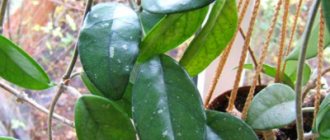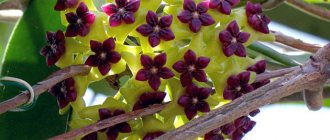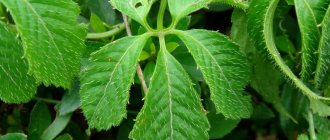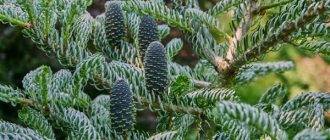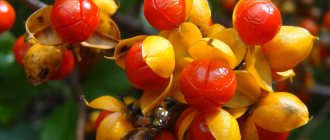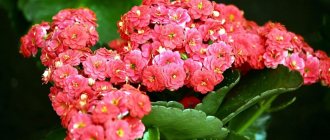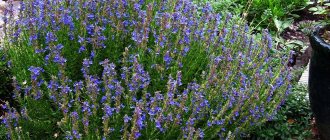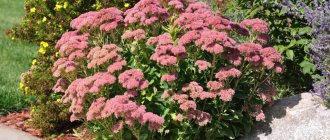Category: Succulents, Care Published 01/04/2019 · Comments: · Reading time: 10 min · Views: 3,531
Hoyas are interesting epiphytic plants that have been attracting the attention of flower growers and breeders for many years with their high decorative properties and beautiful flowering. Today, more than 2 hundred species of these vines have been studied, many varieties have been bred, and among other varieties, Hoya Kerry is distinguished by its unusual heart-shaped leaves. For this feature, in many countries, Kerry is considered a symbol of strong love and marital fidelity. Beautiful bridal bouquets are made from its flowers.
What kind of plant is this and how to properly care for it so that hoya feels good at home and blooms every year?
External characteristics
The stems of an adult plant reach a great length and require support. In the wild, Hoya grows on trees like a vine. Hoya Kerry has several subspecies that differ in the shape and color of the leaves:
- kerrii Variegata - has a yellow variegata in the center of the leaf;
- Spotted Leaves - with speckled leaves;
- Spot center - an elongated leaf with variegated colors in the center;
- Albomarginata - with white edges.
All subspecies have very fleshy leaves, which is why the veins are practically invisible. They have the shape of an inverted heart from 5 to 15 cm in length, the width varies within the same limits.
Flowers are from 1 to 1.5 cm in diameter . Their white color can be diluted with yellow or pinkish. The inflorescences are umbellate. Light intensity changes the brightness of colors. As the plant ages, it secretes more nectar, which gives the flowers darker tones. When flowering, hoya releases a persistent aroma.
What it looks like, what family it belongs to
Hoya (hoya) is part of the Kutrov family, subfamily Lastovnevy. Under natural conditions, it exists as an epiphyte of trees, growing up to 10 m. The shoots have fleshy, heart-shaped foliage. It blooms with small “stars” collected in umbrellas.
Common varieties
Flower growers can find the following varieties:
- Spotted Leaves;
- Variegata (variegated);
- Albomarginata;
- Spot center;
- spot margin;
- "Splash."
Hoya Kerry - ornamental plant
Important! The main difference between the varieties is the color of the leaves.
Briefly about the history of appearance
The name of the vine was given in honor of the gardener Thomas Hoy, who was the first to grow the crop at home.
Is the flower poisonous?
The foliage of the crop contains mild toxic substances. Animals and children should be protected from contact with them.
Hoya variegated as an exotic crop
Is it possible to keep Hoya at home as wax ivy?
Hoya has been compared to ivy for its long creeping stems. In nature, they rest on trees, hanging from them (epiphytes).
Despite all its beauty, some gardeners are afraid to bring hoya into the house because of bad omens . It is believed that ivy brings misfortune, and therefore the vine provokes discord and drives out people dear to the owner, especially men, from the home. But in fact, hoya has nothing in common with ivy , so these signs are not supported by anything.
According to Feng Shui, the plant, on the contrary, creates comfort and coziness in the room . Belief in the ability to resolve conflicts explains its location in the bedroom or in the room where household members gather most often.
Is the flower poisonous?
The foliage of the crop contains mild toxic substances. Animals and children should be protected from contact with them.
Can Hoya wax ivy flower be kept at home?
support for hoya
A curious misconception. Many plants, according to legend, have mystical properties. This also applies to indoor ivy, which wraps around its fellows and deprives them of sunlight.
Here it is more appropriate to lay the blame on a careless grower who allowed the vines to grow wildly. It is common for indoor dwellers to create comfort and absorb harmful substances. And many poisonous varieties, once on the window, acquire medicinal properties.
Ivy will not suppress the growth of its fellows. However, the flower needs to be properly cared for to prevent the vine from growing randomly, which will be able to get caught on any roughness. Special stands are used to guide the stems.
The only contraindication for growing hoya is the presence of an allergic reaction to pollen. In all other respects, the ampelous plant can be classified as harmless. As you can see, the hoya flower is safe, but whether it can be kept at home will be up to you to decide.
Main types and varieties
Most varieties of hoya are vines with dark leaves covered with a waxy coating. The average growth rate is 20–30 cm per year . There are also species with erect shoots, for example Hoya multiflora.
The leaves are solid green, oval-lanceolate in shape. The flowers of wax ivy are the most valuable. Each bud has the shape of a star with a diameter of up to 2 cm, and in its center there is a contrasting core of the same star, only smaller.
The buds are collected in umbrella-shaped or hemispherical inflorescences. On one vine you can count up to 20 of them. The color scheme and shape of the inflorescences underlies the species and varietal differences of Hoya.
Kerry
Hoya Kerry is a vine with shoots up to 2 m, on which there are large heart-shaped leaves (more than 10 cm) and aerial roots. The flowers are white at the base, pubescent along the edges, and yellow in the middle.
Over the years, the flowers on the vine become darker.
Interesting! This species was first found by the American A. Kerry in northern Thailand in 1911.
Fleshy
Hoya fleshy has dark oval leaves, along the edge of which there is a noticeable light rim of a yellowish tint. Over time, the stems become covered with rough bark. Pink flowers are fleshy without blooming into thin petals.
Hoya lace
Hoya lacunosa is an epiphyte. It has dark green diamond-shaped foliage, reaching a length of 6 cm. Flowers in white inflorescences (15-20 pieces) and a yellow crown in the center are covered with pile, collected with umbrella buds. The plant's vines are dense and do not climb on their own. Flowering occurs from late spring to mid-autumn.
Hoya multiflora
Hoya multiflora is a bushy plant with wavy waxy leaves of a dark green color, reaching a length of 10-12 cm. Thin woody stems do not curl - they are erect. It is grown as an ampelous plant, reaches a height of 60 -70 cm. The inflorescences are yellow-white (up to 40 pcs.), the lower part of the flowers is curved, the resulting buds have an umbrella shape. It has a pleasant lemon aroma during flowering. The formation of buds occurs at the beginning of summer and mid-autumn.
Hoya majestic
Hoya imperialis is a liana with curly thin stems reaching a length of 8 m. The foliage is large (length 20 cm), oblong, dark green in color, glossy. Umbrella inflorescences consist of ten large flowers of a purple hue, the core is white. During flowering they emit a fruity aroma. Buds form in spring and summer.
Hoya australian or southern
Hoya australis is a 10 m long liana with large dense waxy oblong leaves 15 cm long. The color of the foliage can be light or dark green. In one umbrella bud there are up to ten flowers of white-pink or cream color, which emit a spicy aroma. Blooms mainly from late summer to November.
Hoya fluffy cup
Hoya pubicalyx is a climbing vine 7 m long, with large oblong waxy leaves (length 14 cm) of green color with silver spots. It is characterized by a variety of shades of inflorescences - from light pink to dark burgundy and even black and burgundy. The basket inflorescence is formed by 30 flowers that emit a perfume aroma. Blooms in summer.
Fertilizing, soil selection and planting
My hoyas are not spoiled by fertilizing, but, nevertheless, they bloom and develop very well on their own. If your plant is rather frail and does not bloom, you can fertilize it when watering with liquid fertilizer added to the water. A fertilizer for flowering indoor plants or one intended for succulents and cacti is suitable. There is no need to feed Hoya often - once a month from spring to autumn is enough.
For Hoya Kerry, a soil mixture for cacti and succulents is suitable. I also add soaked coconut fiber to the purchased soil. It makes the soil more airy and lighter; not a single hoya growing in such a soil mixture has ever rotted.
There is no particular need for transplantation of this hoya; it grows quietly in the same pot for many years. If you decide to replant the plant, be careful not to damage the root system. Therefore, it is better not to shake off all the soil from the roots, but take the hoya out of the old pot, place it in a new one with an earthen lump and simply add the required amount of fresh soil.
Hoya care at home
The beauty does not need an annual transplant; this can be done once every couple of years. The plant needs special soil, and therefore it is recommended to replant immediately after purchase. In addition, often in specialized stores the ivy could be given stimulating fertilizing so that it does not lose its shape.
The soil should be:
- light;
- nutritious
- have good water permeability;
- the soil is neutral or slightly acidic.
There is an opinion that high-quality garden soil with the addition of sand is suitable for ivy. It is advisable to disinfect it before planting in order to protect yourself from problems with infection.
But still, the best solution would be to prepare a mixture of the following composition:
- turf;
- humus;
- peat;
- sand;
- leaf soil is twice the amount of other ingredients.
Lighting requirements
The green parts will grow well in a shaded place, but for flowering you will need light, because... wax ivy is a light-dependent creature.
In order to properly grow one or another species, it is necessary to prepare a bright area for each individual individually. You must remember to take care of protection from direct sun exposure with the onset of summer, but at the same time avoid shading. The most ideal place would be a window facing east or west. In the first winter month, the pot can be moved to the southern room, but the plant that remains in place will not suffer either. A sharp increase in light activity in spring can harm the beauty, so it is recommended to gradually adapt it to new conditions.
Important! The plant does not tolerate being moved to another place during the formation of buds and the entire period until half flowering.
Correctly selected temperature conditions
It is not so difficult to choose a comfortable temperature for indoor vines. Liana will feel great at average room temperatures. Extreme heat is also not a problem for her, but it is best if the thermometer mark is at +18 - +20 degrees.
Year-round cultivation can be carried out indoors, but when November comes, it is recommended to lower the temperature by a couple of degrees and leave it like that until February . The minimum permissible value for a vine is +12 - +15 degrees, which is suitable for most species. But Hoya Bella will require +18.
Do not deprive the plant of fresh air. The room with vines should be regularly ventilated. You should not place a flower on a balcony or loggia. If it’s winter outside, you need to remember to protect from cold air masses.
How to water and fertilize
The liana will need watering as soon as the soil dries, the permissible depth of soil drying is up to 3 cm. In the summer months, water once every 7 days, and with the onset of winter, they switch to once every two weeks. For irrigation, it is recommended to use settled water at room temperature.
- It is recommended to spray the vines , but avoid getting water on the flower petals; the plant will only appreciate the increased humidity.
- You can bathe the vine in a warm shower, and not just limit yourself to periodically wiping the leaves with a damp cloth.
Hoya is a large plant, but it does not need frequent feeding. It is recommended to use complex universal products that include nitrogen, phosphorus and potassium components.
Transfer
Hoya Kerry does not need frequent replanting. For a succulent, it is enough to change its pot every few years. With young plants, this manipulation can be carried out more often - once every 1-2 years, as necessary.
To replant, you need either a new pot or a sterilized old one. Even a newly purchased container must be washed with soap and water before use.
Important! When moving a vine, its roots must not be damaged, so the old soil is not shaken off from them. The transplant is carried out in mid-spring, after awakening. It is undesirable to touch the vine in winter, as well as in summer, during the period of vigorous flowering.
Trimming
Pruning has a negative effect on Hoya Kerry: such planned manipulations can harm the plant. In some cases, pruning is carried out if:
- there is a diseased leaf;
- need escape for reproduction. Then choose the one that has never bloomed.
Old inflorescences are not removed. New flowers will appear from these same places next summer.
Hoya propagation
Using cuttings and layering, you can obtain additional samples of Noua at home.
Hoya propagation by cuttings
Cuttings are effective in mid-spring or early autumn. Woody cuttings must have at least four leaves. Sections of the stem are made a couple of centimeters below the leaf node.
When the cuttings are prepared, you need to do the following steps:
- stimulate root formation of cuttings by keeping them for at least 24 hours in a root solution;
- choose the basis for rooting (water, sand, soil substrate);
- place the cuttings in containers with a base and cover with film;
- ensure the room temperature is not lower than +20°C;
- after a month, transplant the rooted cuttings into a flower pot with previously prepared nutrient soil;
- To stimulate flowering, pinch the tops of young shoots.
Reproduction by layering
A more simplified method of propagation is the formation of layering:
- the shoots of the flower are folded into a curved arc;
- bend the top of each arc to the first layer of soil and sprinkle it with soil;
- within two to three weeks, roots form on the sprinkled area of the shoot;
- part of the stem with roots is separated with pruning shears and transferred to a separate pot with previously prepared nutrient soil.
Layering can also be done using small cuts on the flower stems. When the cut areas are moistened (winding the stems with moss), root growth is stimulated.
Diseases and pests
The cause of flower malaise at home can be:
- spider mite;
- mealybug;
- thrips;
- aphid;
- scale insects;
- fungus;
- root rot.
In every flower shop you will find special products against major pests. But no treatment will work if the vine is kept in a room with dry air.
This is the main cause of both diseases and the appearance of parasites.
In addition to special medications, folk remedies can be used against parasites. A good medicine against most parasites is a mixture of 15 g of garlic and the same amount of onion, poured with 1 liter of water.
The entire plant is washed with this liquid. Against scale insects, you will also need to manually collect all the insects from the vine, wash it with a solution of laundry soap, and then rinse with onion-garlic water.
If you notice signs of rotting on the leaves, it is a result of over-watering or a sign of unsuitable soil that is retaining water. Reduce watering and do not overuse tree bark or coconut fiber mats the next time you replant.
Did you know? Hoya Kerry is known in Feng Shui practice as the guardian of the family. The best place for it is considered to be the bedroom.
Hoya Kerry is suitable for patient and caring owners: you should not expect rapid growth from it. The most important thing in caring for it is to maintain the required air humidity and not disturb the plant during hibernation.
Then, after a couple of years of care and love, the vine will give those around it its unique color, filling the room with a delicate caramel aroma.
Reproduction methods
There are several methods. They differ in the complexity and time it takes to obtain new copies.
By layering
The method is to use stem fragments. Select a shoot, then use a sharp knife to make a small cut on it near the surface of the substrate. The wound is covered with damp moss, which is watered periodically to prevent it from drying out. The incision site is covered with polyethylene. When the first roots appear, the shoot is separated from the mother plant. The finished cuttings can be immediately planted in an individual pot.
Stem layering
It is allowed to form a layer without making an incision. In this case, part of the stem is placed horizontally, fixed at the surface of the ground and covered with moss. This measure will help the formation of roots. After their development, the fragment is cut off from the original specimen. To propagate using this method, you should use plants that have already bloomed at least once.
Leaf
The leaves are planted in the ground and wait for the root system to appear. This method is less successful than cuttings. In half of the cases, root development does not occur and the foliage dries out.
Leaf propagation is the most popular method of propagating vines.
Cuttings
With this method, a suitable stem is selected and cut with a sterile instrument. There should be no more than 3 leaf plates on the shoot. It is necessary to ensure that the fragment has several “nodes”: roots will begin to form on them.
Prepare the container in advance: take an opaque container, fill it with water at room temperature (about 22˚C) and cover it with foil, wrapping the edge tightly. The cuttings are treated with a root formation stimulator (“Kornevin”, “Heteroauxin”, “Epin”). At the lower node, the leaf plate is removed. Then, through the holes in the foil, the shoots are immersed in the liquid.
After 2–3 weeks, the cuttings will grow roots, after which they can be planted in separate pots.
Seeds
At home, this method of propagation is rarely used: Hoya Kerry rarely produces pods from which seed material can be extracted. Some time after their appearance, they burst, revealing a “cloud” of bundles of shiny white fibers, at the ends of which there are fruits. They should be carefully separated and dried for 2-3 days, spread out on paper in a shaded place. After this, you can begin planting.
Hoya Kerry seeds remain viable for no more than one year, so it is better to hurry with planting them.
Prepare the container by filling it with a suitable substrate (we wrote about the composition of soil for hoya above), which is watered with settled water. The seeds are laid out on the surface of the soil, keeping a distance of 3.5–4 cm between them. The fruits are sprinkled with a thin layer of soil (0.8–1 cm) on top. The soil is periodically irrigated with a spray bottle.
In about a week, the first shoots will begin to appear. They need to be watered moderately every 2 days. Young sprouts require good lighting, so they can be placed directly on the windowsill on the east or west side.
Hoya shoots
The air temperature should not exceed 22˚C. After 3–4 leaf blades appear, new specimens are planted in individual pots.
Reproduction
Like most plants in this group, Hoya Kerry can be propagated from internodes. In addition, it reproduces by rooting even one leaf, but not always successfully. On the stems of hoya you can easily see small aerial roots, so cut off internodes can take root quite easily.
Unfortunately, even “green valentines” are not so easy to find in our regular stores. Therefore, if you want to get a Hoya Kerry, you will have to struggle with searching for it. But on the Internet there are a lot of forums for indoor plant lovers who will be happy to share with you either a leaf, an internode, or an already rooted cutting.
Medicinal properties of hoya
This flower not only decorates, but also heals. Calms the nervous system, elevates mood, relieves headaches, helps with skin diseases and heals purulent wounds. The leaves are used to treat all these diseases.
Headaches are treated by placing a leaf on the temple. Skin problems are solved by grinding the leaves into a paste, which is applied to the damaged area and wrapped in a bandage.
Side effects: The smell emitted by the flowers can cause severe headaches. Therefore, people with chronic migraines should avoid this plant. The leaves also cause dermatitis in allergy sufferers.
Common mistakes gardeners make
Unsuitable conditions lead to a decrease in the decorative value of the vine. Sometimes it can be difficult to determine the cause of yellowing, lethargy of leaves, or lack of flowering. The table will help you understand the mistake made and find a way to help the plant.
Table - Errors gardeners make when growing hoya
Problem that has arisen Possible causesHelp the plant
| Yellow spots appear on the leaves | Exposure to direct sunlight, burns | The south window provides shade from the midday sun |
| Hoya's leaves are falling | — Prolonged drying out of the soil; - waterlogging combined with cold | — Normalize the watering regime; - adjust the conditions of detention |
| Wax ivy turns yellow and withers | — Low air humidity; - pest damage; - prolonged heat; - rotting of the root system | — Inspect for the presence of pests; — improve living conditions; - if rot is suspected, replant after pruning damaged roots |
| The leaves are turning pale, the hoya is growing slowly | Nutritional deficiencies | — Transplanted into new, nutritious soil; - regularly apply balanced fertilizer |
| Leaves wrinkle and dry out | — Hypothermia; - watering with cold water | - Move to a warm place; - water for irrigation is kept at room temperature for a day |
| The ends of the leaves dry out | — Low humidity; - heat | Sprayed more often |
| The buds are falling | — Rearranging the pot; - a sharp change in conditions of detention; - low humidity | At the stage of bud formation and flowering, try not to disturb the plant. |
| Wax ivy does not bloom | — Poor lighting; - large pot; - lack of nutrition; - warm winter; - trimming flower stalks | — Eliminate mistakes made; - arrange a period of rest |
Water the hoya only with soft water. You can soften water using peat. About 100 g of peat is poured into a fabric bag and placed in a two-liter jar of water. In a day, the water will become soft and suitable for irrigation.
Other problems
Illnesses of an exotic guest are associated with improper care:
- rotting of the root system and green parts is caused by an excess of moisture in the soil;
- burns on foliage occur when exposed to direct sunlight;
- frequent moving from place to place in the house will cause the buds to fall off.
The exotic liana is an undemanding crop, can grow in apartment conditions, and is easy to care for. Its long shoots require sufficient space, and its unusual buds will decorate the room for six months.
Diseases and pests of Hoya Kerry
The tropical plant is not weak, not capricious, and gets sick quite rarely. However, it can also be infected by fungal, viral, bacterial microorganisms, and also suffer from parasitic insects. Most often, illnesses arise due to violations of the rules of care or maintenance of the vine in unsuitable conditions.
Overwatering is the most dangerous thing for Hoya Valentine. It often leads to rotting of the root system and if this part of the plant is severely damaged, then it is impossible to save it. Then it can be cut into cuttings and rooted - in water or soil.
As for parasites, even on a home flower you can find scale insects, aphids, whiteflies or thrips. They feed on the sap of the vine, taking away important nutritional elements from it, which leads to the drying out of the foliage and flowers. In addition, many parasites leave secretions on the leaves, on which mold and other pathogens grow.
To rid Hoya of uninvited “inhabitants,” it is recommended to remove them manually, treat the foliage with a soap solution, and then with an insecticidal agent, for example, Aktara.
If the air is too dry, spider mites can settle on the Kerry foliage. It is easy to remove it with the special acaricidal drug Sunmite, but this should be done at the first sign of infection.
It is important! The sweet, aromatic nectar of Hoya Kerry can cause an allergic reaction. Therefore, if there are allergy sufferers in the house, then it is better not to plant it or place it in a shady place so that the vine does not bloom.

